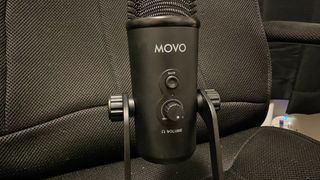Tom's Guide Verdict
The Movo UM700 is not quite as good a USB microphone as the Blue Yeti, but it’s more than serviceable. Whether podcasting, streaming or gaming, the UM900 provides reliability at a portion of the cost of its competitor.
Pros
- +
Affordable price
- +
Plug-and-play
- +
Sturdy and snug design
- +
Great for beginners
Cons
- -
“Quiet” mic leads to periodical gain adjustments
- -
Sensitive to shocks/bumps
Why you can trust Tom's Guide
“To be the best, you have to beat the best.” That’s the quote that came to mind when I was introduced to the Movo UM700 USB microphone, dubbed the “Blue Yeti killer” by some. I’ve owned the Blue Yeti, one of the all-time best microphones, for years and wanted to see if the moniker rang true.
Connection: USB
Ports: Micro USB, 3.5mm aux out
Condensers: 4
Dimensions: 4.4 x 3.8 x 11.6 inches
Weight: 2.3 pounds
After putting the UM700 to the test, I still have my preference in terms of the Blue Yeti, but this upstart mic proved capable of getting the job done. Keep reading our Movo UM700 for the full verdict.
- Our picks of the best microphones for gaming, streaming and podcasting
- The best headphones with a mic for voice and video calls
Movo UM700 review: Price and availability
The Movo UM700 is available from Movo and at Amazon for $99, a smooth $30 less than its chief competitor, the Blue Yeti.
While there are other USB microphones at this price level, like the JLab Talk and Blue Yeti Nano, that $30 saving is significant for a podcaster or streamer just getting into the game, and the UM700 certainly provides plenty of bang for the buck.
Movo UM700 review: Design

It’s clear that the UM700 takes a lot of its design inspiration from the Blue Yeti. At the same time, it takes some of its rivals’ features and improves upon them — even at the point of opening up the box.
As someone who’s been podcasting for a while, I appreciate the little things. Upon opening the box, I saw that the cover for the top of the microphone doubled as a pop filter. Normally, you’ll have to go through the additional hassle of ordering one or trying to find one that fits at your local music store. That type of customer service is impressive and functional.
While the little things are impressive, the entire body of work is nice as well. The UM700 has a nice metal finish and is decidedly sturdy. I would describe the moving parts of the mic and stand as “snug” — even when I put the USB cable in my MacBook, it was decidedly secure. Yep — the mic has a snug and sturdy feel, but not stiff. This implies craftsmanship, and again, attention to detail.
One thing that’s clear when comparing the two mics is that the UM700 aspired to be a sleeker incarnation of the Blue Yeti. It accomplishes that task, as it is slightly lighter (just over a pound less) and takes up a little less space. Keep in mind, the mic/stand combo may be slightly clunky on your desk. I’ve generally learned to allot the space for a mic and stand in my modest podcast setup.
The buttons and knobs on the UM700 are virtually the same as the ones on the Yeti, as are the directional pattern modes — stereo, cardioid, omnidirectional and bidirectional. I like the mute button feature on the UM700 better than the one on the Yeti, as the UM700 clearly shows when the mute button is and is not being used. The indicator light turns red when it is being used. I never liked the perpetually red mute button with the Yeti, as a blinking indicator means that the mute function is operative.
An essential component for beginning podcasters is plug-and-play capability. The UM700 certainly has that, as you can plug in the micro USB end of the cable into the mic, the full-side USB end into your computer and get right to work (or play).
Movo UM700 review: Sound quality

As much as I enjoyed the experience of opening up the box, the Movo UM700’s real value would ultimately be determined by sound quality. I began by putting the mic to the test in an episode of my podcast. The plug-and-play components worked perfectly, and Garageband recognized the mic without installing software.
I pressed record and began to speak as I listened through my headphones, using the 3.5mm aux jack on the underside. The UM700 quickly revealed itself to be a very quiet mic, in the sense that it was very hard to determine whether the sound was being picked up clearly. That’s not a deal breaker by any means; it simply meant I had to play with the gain button a good bit, and I had to turn the gain knob to a moderate level to ensure that I had the volume I wanted. Of course, that opens up the opportunity to pick up sounds that you don’t want. In short, as I would with most mics, I would highly recommend that you record in an area where there is little to no background noise.
I primarily recorded in cardioid mode, and it was more than functional. I eventually toggled between the other modes, including the bidirectional mode. These other modes were functional, but mostly indistinguishable. With that said, it’s always important when podcasting to use the mode that best suits your guest or guests; bidirectional, for instance, works best when it’s just you and one other speaker sat opposite one other.
Overall the UM700 performed adequately from start to finish, but did it sound better than the Blue Yeti? Unfortunately for Movo, not quite. I felt that recordings made with the Yeti required less pre- and post-production editing to sound their best, which in turn makes it more of a true plug-play-production mic than the UM700.
Movo UM700 review: Verdict
Although the UM700 isn’t quite the “Blue Yeti killer,” it is a mic worthy of merit. At a little under $100, it has everything a beginning podcaster, streamer or gamer needs to get started. With its attention to detail and innovation, it will be interesting to see how Movo improves upon its mic design and function as time progresses.
- More: We've tested the best PC speakers
Ken J. Makin is a tech and entertainment writer for Tom’s Guide, and has nearly 20 years of experience as a journalist. He’s an avid podcaster and freelancer for various sites, including ESPN’s The Undefeated and The Christian Science Monitor. When he’s not podding or writing, Ken is likely spending time with his wife and children.


